"Dressage"
The word itself is simply French for training. As an equestrian competition it is at it's most basic level, a test of the horse's training and willingness to work with a rider. In the case of pony play the idea is very similar, it is the test of the pony's training and responsiveness to his/her trainer. Both the pony and trainer will be judged on how they complete the course.
Judging Guidelines
Each round will consist of a series of five moves along five separate courses. The order of the moves and courses will be determined randomly before each round. The trainer will then guide the pony through the order of the course. Only the judges and the trainer will know the order, the pony will not. The order of the course will be given to the trainer by the judges, using a notecard, at the beginning of the round.
Judging will be on a scale from 0-5
0 meaning that the move was not completed
5 meaning it was completed flawlessly
Each score is given in whole numbers only, so no 4.5's or 2.5's etc
There will also be 5 categories on which each pony/trainer duo will be judged for overall performance.
Accuracy - The pony's accuracy in following the figures of the arena (stay within the lines, the lines are our friends). Each of the five courses on the dressage field will be given an accuracy rating.
Command - How well the trainer commands the pony within the ring. Only one rating for this is needed, and will be judged after the round.
Presentation and Behavior - This is a broad category covering how well they work as a team. Is the pony well cared for, eager to please? The pony attitude will be a factor, how well she behaves and acts. Only one rating for this is needed, and will be judged after the round.
Responsiveness - The pony's willingness and speed at obeying commands as they are given. Only one rating for this is needed, and will be judged after the round.
Rhythm - The smoothness in which the pony moves about the dressage ring, specifically in transitions both from curves to straight and from figure to figure. Only one rating for this is needed, and will be judged after the round.
There will be three judges for each dressage event. Dropping the highest and lowest score, and averaging the remaining scores together will compute the score for each round. Each judge’s score will be averaged together to produce the final score for the round.
The judges will be able to observe the complete dressage arena, usually from an aerial platform. Judges will not be allowed to be a trainer or a pony for the dressage they are judging. Only the trainer and pony will be allowed on the dressage arena during a current round.
Moves will be judged in the following manner and cannot be scripted:
1. Prancing in a straight line, using a forward motion for a predetermined set distance of 10 meters. The pony will be judged on how close they start and stop on the marked stops on each line, and on how tightly they follow the line.
2. Prancing in a straight line, using a backward motion for a predetermined set distance of 10 meters. The pony will be judged on how close they start and stop on the marked spots for each line, and on how tightly they follow the line.
3. Moving in a circle around a reference point with an even circumference, completing three turns. The pony will be judged on how they prance on the line, and how close they start and stop on the marked spots on the circle.
4. Moving in a figure eight with the circles circumferences of each one being even, completing three turns. The pony will be judged on how they prance on the line, and how close they start and stop on the marked spot on the figure eight.
5. Moving on a slalom course, moving in between pylons as tightly as possible. The pony will prance up once, turn around and prance back. The pony will be judged on how smoothly she/he moves, and how close they start and stop on the marked spots. Speed for the slalom course will not be judged.
The pony and trainer will not be allowed to leave the Dressage arena during a round. Fully crossing the arena boundaries with both hooves or both feet will lead to a deduction of one point from the total final score for each round.
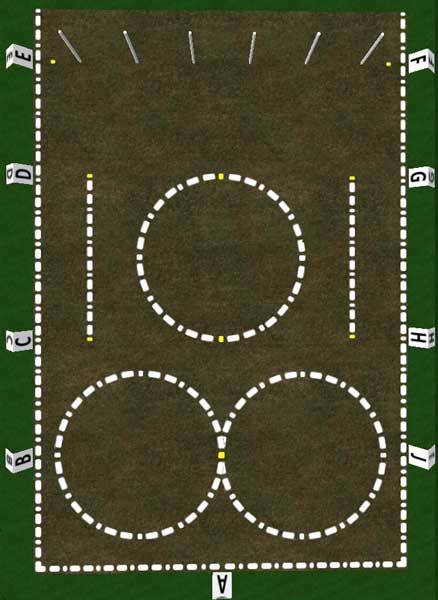
Dressage Courses
The
dressage field will be composed of five separate courses:
- Figure-eight
- Circle
- Two 10-meter lines
- Slalom with 6 poles
The field
is rectangular, the figure-eight course is on one end and the slalom
course will be on the opposite end. In the middle will be the two
lines, bordering the rectangular lengthwise with the circle in the
middle. An image of the course is provided at the right >>
Surrounding
the dressage field is a series of letter signs from A to H, and J.
These letters ares use by the trainer to determine the order and which
move is required. The dressage round notecard is given to the trainer
by the judges, and will list the order these moves should be performed.
Letter
A is always on the same end of the field as the figure-eight. Letters B thru C will be
on the trainer/pony left, when looking from the A sign, along the dressage
field border. Letters F thru H, and J will be on the trainer/pony
right along the dressage field border.
Each
of the letters will correspond to a marker on the dressage field.
These letters will tell the trainer which move the pony must execute,
and in which direction the pony must turn or move. The markers are used
by the trainer and pony to easily identify the starting and stopping
point for each of the 5 moves. The direction and move each pony must
make is listed below;
A. This is the exit and entrance point for the trainer and pony. Each round starts and ends here.
B.
This is for the figure-eight. The trainer stands in the figure-eight
with the marker in front of her, facing the letter B sign. This tells
the pony to walk to the spot in front of the trainer, face the slaloms,
and then walk the figure-eight. The direction is determined by which
sign the trainer is facing; that is, the pony will walk the figure-eight
three times turning towards the B sign at the start. (The direction is reversed if the trainer faces the J sign as explained below.)
C. This
is for the line and the circle, and will be denoted on the dressage
round notecard as Line C or Circle C. If the line is required the
trainer will stand with the line marker in front of him facing the
letter C sign. The pony will walk over to the mark and walk forward on
the line using the forward motion, stopping at the end of the line to
wait for the next move. If the circle is required the trainer will
stand by the circle mark, with the marker in front of her, facing the
letter C sign. The direction for the pony to walk the circle is
determined by the direction the trainer is facing, which will be three
clockwise turns around the circle.
D. This is for the line and
the circle, and will be denoted on the dressage round notecard as Line D
or Circle D. If the line is required the trainer will stand with the
line marker in front of him facing the letter D sign. The pony will
walk over to the mark and walk backwards on the line using the backward
motion, stopping at the end of the line to wait for the next move. If
the circle is required the trainer will stand by the circle marker, with
the marker in front of him, facing the letter D sign. The direction
for the pony to walk the circle is determined by the direction the
trainer is facing, which will be three counter-clockwise turns around
the circle.
E. This is for the slalom. The trainer will stand
with the slalom marker in front of her, facing the field boundary line
the slalom runs parallel with. The pony will walk over to the mark,
face the slalom poles and walk up once, turn around and walk back to the marker.
F.
This is for the slalom. The trainer will stand with the slalom marker
in front of him, facing the field boundary line the slalom
runs parallel with. The pony will walk over to the mark, face the
slalom poles and walk up once, turn around and walk back to the marker.
G.
This is for the line and the circle, and will be denoted on the dressage
round notecard as Line G or Circle G. If the line is required the
trainer will stand with the line marker in front of her facing the
letter G sign. The pony will walk over to the mark and walk backwards
on the line using the backward motion, stopping at the end of the line
to wait for the next move. If the circle is required the trainer will
stand by the circle marker, with the marker in front of her, facing the
letter G sign. The direction for the pony to walk the circle is
determined by the direction the trainer is facing, which will be three
clockwise turns around the circle.
H. This is for the line and
the circle, and will be denoted on the dressage round notecard as Line H
or Circle H. If the line is required the trainer will stand with the
line marker in front of him facing the letter H sign. The pony will
walk over to the mark and walk forward on the line using the forward
motion, stopping at the end of the line to wait for the next move. If
the circle is required the trainer will stand by the circle mark, with
the marker in front of him, facing the letter H sign. The direction for
the pony to walk the circle is determined by the direction the trainer
is facing, which will be three counter-clockwise turns around the
circle.
J. This is for the figure-eight. The trainer stands
in the figure eight with the marker in front of her, facing the letter J
sign. This tells the pony to walk to the spot in front of the trainer,
face the slaloms, and then walk the figure eight. The direction is
determined by which sign the trainer is facing. So the pony will walk
the figure eight three times turning towards the J sign to start.
Dressage Actions
The
Trainer and pony will always enter the dressage field from the letter A
sign. The Judges will give them the dressage round order notecard and
will indicate when to begin. The trainer and pony will both step onto
the field. The trainer will tell the pony to bow (using verbal command,
a crop, or a whip). The bow is always facing the end of the field
where the slalom course is. (In Silent Dressage, the Pony will bow without command after stepping on to the field and aligning him/herself next to the trainer.)
The trainer will then move to the
first course listed in the dressage round order notecard. The pony will
wait until the trainer indicates that the pony can move over to the
first course. The trainer will be allowed to move to the next course
once the pony has started the previous course. Judging is based on how
both trainer and pony walk the field.
Once all courses are
finished the trainer will return to the point on the field where they
entered. The pony will walk over when ready and stand to the trainer’s
right or left side. The trainer will tell the pony to bow for the judges
(using verbal command, a crop, or a whip). Then both trainer and pony
will turn around and exit the field. (In Silent Dressage, the Pony will bow as soon as s/he is aligned next to the trainer.)
There will be two options
for the trainer to command and guide the pony. For a normal Dressage
the trainer my use verbal commands to tell the pony where to go. The
trainer will move the marker shown on the dressage round order notecard,
and may say “Line C, “Circle H”, or “B”. The pony will then be guided
by the trainer’s voice.
The other option is the Silent Dressage,
where no verbal commands are spoken and the trainer then walk to the
marker indicated on the dressage round order notecard, and the pony is
guided by the trainer’s position. The judges will determine which type
of dressage is to be performed.

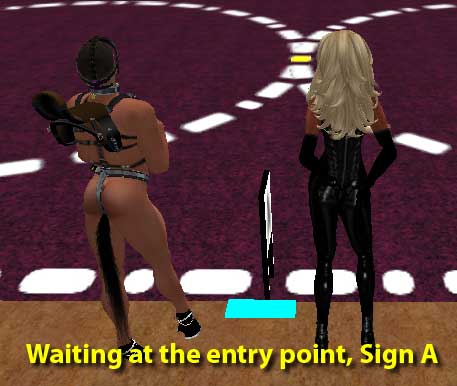

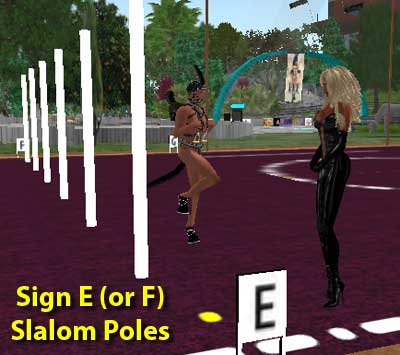
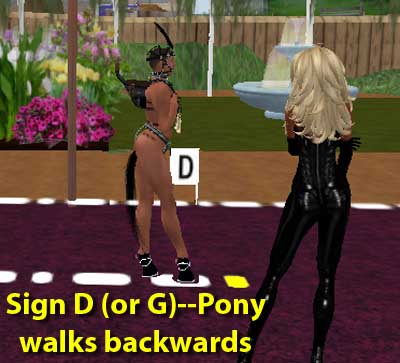
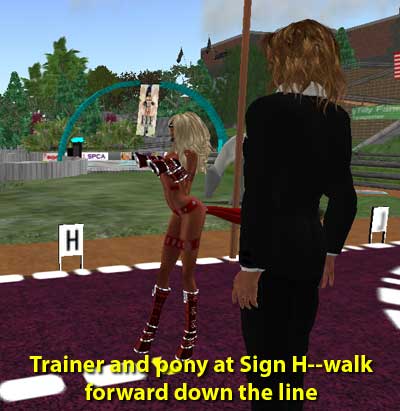
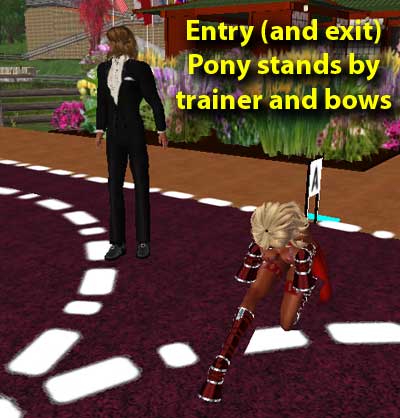
UK Style Dressage
(This section was entered by Trina Varriale on October 31, 2011. It is NOT official; it is here for information and discussion. The material is based on a conversation between Trina and Pony Seraphim, who has considerable RL experience in dressage.)
This section has to do with the ROUTE that the pony takes from one pattern to the next. SL trainers have been teaching ponies to walk directly from the endpoint (e.g., yellow square) of the pattern to the next.
However, in dressage in RL in the UK, the pony would follow the EDGE of the field go go between patterns. In fact, a key factor in judging is how closely the pony follows the edge without touching it.
Seraphim and I are going to experiment with some guidelines of how we might emulate this very elegant way of transitioning between patterns. It may be possible to offer this as an option for ponies wishing to move to a more advanced level in Dressage training.